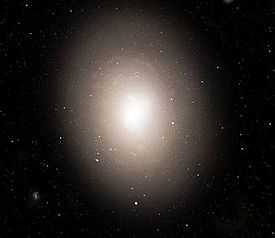IC 1101
| IC 1101 | |
|---|---|
|
Photometric image of IC 1101 | |
| Observation data (J2000 epoch) | |
| Constellation | Virgo |
| Right ascension | 15h 10m 56.1s[1] |
| Declination | +05° 44′ 41″[1] |
| Redshift | 0.077947±0.000087[1] |
| Helio radial velocity | 23,368 ± 26 km/s (14,520 ± 16 mi/s)[1] |
| Galactocentric velocity | 23,395 ± 26 km/s (14,537 ± 16 mi/s)[1] |
| Distance |
1.045±0.073 billion ly (320.5±22.4 Mpc)h−1 0.73[1] |
| Group or cluster | Abell 2029 |
| Type | E/S0[2] |
| Size (ly) |
210±39 thousand ly (65±12 kpc) effective radius[3] |
| Number of stars | 100 trillion (1014) |
| Apparent dimensions (V) | 1'.2 × 0'.6[1] |
| Apparent magnitude (V) | 14.73[1] |
| Other designations | |
| UGC 9752,[1] PGC 54167,[1] A2029-BCG[1] | |
IC 1101 is a supergiant elliptical galaxy at the center of the Abell 2029 galaxy cluster, approximately 320 megaparsecs (1.04 billion light-years) from Earth.[1]
Characteristics
The galaxy is classified as a supergiant elliptical (E) to lenticular (S0)[2] and is the brightest galaxy in A2029 (hence its other designation A2029-BCG; BCG meaning brightest cluster galaxy).[4][5] The galaxy's morphological type is debated due to it possibly being shaped like a flat disc but only visible from Earth at its broadest dimensions. However, most lenticulars have sizes ranging from 15 to 37 kiloparsecs (50 to 120 thousand ly).[6]
IC 1101 is among the largest known galaxies, but there is debate in the astronomical literature about how to define the size of such a galaxy. Photographic plates of blue light from the galaxy (sampling stars excluding the diffuse halo) yield an effective radius (the radius within which half the light is emitted) of 65±12 kpc (212±39 thousand ly).[3] The galaxy has a very large halo of much lower intensity "diffuse light" extending to a radius of 600 kpc (2 million ly).[7] The authors of the study identifying the halo conclude that IC 1101 is "possibly one of the largest and most luminous galaxies in the universe."[7]
Like most large galaxies, IC 1101 is populated by a number of metal-rich stars, some of which are seven billion years older than the Sun, making it appear golden yellow in color. It has a bright radio source at the center, which is associated with a massive black hole.
Discovery
The galaxy was discovered on 19 June 1790 by the British astronomer Frederick William Herschel I. It was catalogued in 1895, more than 100 years later, by John Louis Emil Dreyer as the 1,101st object of the Index Catalogue of Nebulae and Star Clusters (IC). At its discovery, it was identified as a nebulous feature. Following Edwin Hubble's 1932 discovery that some of the "nebulous features" were actually independent galaxies, subsequent analysis of objects in the sky were conducted and IC 1101 was therefore found to be one of the independent galaxies.
See also
References
- ↑ 1.0 1.1 1.2 1.3 1.4 1.5 1.6 1.7 1.8 1.9 1.10 1.11 "NED results for object IC 1101". NASA/IPAC Extragalactic Database. Retrieved 11 November 2006.
- ↑ 2.0 2.1 "IC 1101 -- Brightest galaxy in a Cluster (BCG)". SIMBAD. Retrieved 21 December 2014.
- ↑ 3.0 3.1 Fisher, David; Illingworth, Garth; Franx, Marijn (January 1995). "Kinematics of 13 brightest cluster galaxies". The Astrophysical Journal 438 (2): 539–562. Bibcode:1995ApJ...438..539F. doi:10.1086/175100.
- ↑ Lewis, Aaron D.; Buote, David A.; Stocke, John T. (March 2003). "Chandra Observations of A2029: The Dark Matter Profile Down to below 0.01rvir in an Unusually Relaxed Cluster". The Astrophysical Journal 586 (1): 135–142. arXiv:astro-ph/0209205. Bibcode:2003ApJ...586..135L. doi:10.1086/367556.
- ↑ Uson, Juan M.; Boughn, Stephen P.; Kuhn, Jeffrey R. (October 1990). "The central galaxy in Abell 2029 - an old supergiant". Science 250 (4980): 539–540. Bibcode:1990Sci...250..539U. doi:10.1126/science.250.4980.539.
- ↑ Seligman, Courtney. "NGC Objects: NGC 50 - 99". Cseligman.com. Celestial Atlas. Retrieved 14 April 2015.
- ↑ 7.0 7.1 Uson, Juan M.; Boughn, Stephen P.; Kuhn, Jeffrey R. (March 1991). "Diffuse light in dense clusters of galaxies. I. R-band observations of Abell 2029". The Astrophysical Journal 369: 46–53. Bibcode:1991ApJ...369...46U. doi:10.1086/169737.
External links
- Wilford, John Noble (26 October 1990). "Sighting of Largest Galaxy Hints Clues on the Clustering of Matter". The New York Times.
- "The Scale of the Universe - Interactive". Astronomy Picture of the Day. 12 March 2012.
- IC 1101 on WikiSky: DSS2, SDSS, GALEX, IRAS, Hydrogen α, X-Ray, Astrophoto, Sky Map, Articles and images
